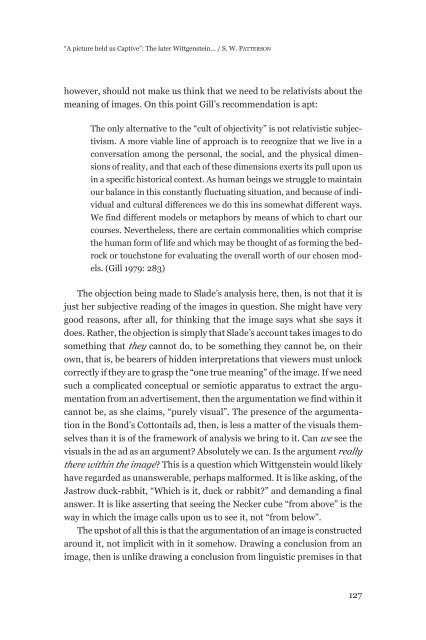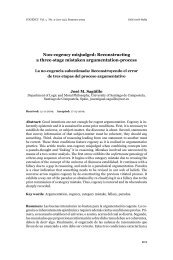Cogency v2 n2
Cogency v2 n2
Cogency v2 n2
Create successful ePaper yourself
Turn your PDF publications into a flip-book with our unique Google optimized e-Paper software.
“A picture held us Captive”: The later Wittgenstein... / S. W. PATTERSON<br />
however, should not make us think that we need to be relativists about the<br />
meaning of images. On this point Gill’s recommendation is apt:<br />
The only alternative to the “cult of objectivity” is not relativistic subjectivism.<br />
A more viable line of approach is to recognize that we live in a<br />
conversation among the personal, the social, and the physical dimensions<br />
of reality, and that each of these dimensions exerts its pull upon us<br />
in a specific historical context. As human beings we struggle to maintain<br />
our balance in this constantly fluctuating situation, and because of individual<br />
and cultural differences we do this ins somewhat different ways.<br />
We find different models or metaphors by means of which to chart our<br />
courses. Nevertheless, there are certain commonalities which comprise<br />
the human form of life and which may be thought of as forming the bedrock<br />
or touchstone for evaluating the overall worth of our chosen models.<br />
(Gill 1979: 283)<br />
The objection being made to Slade’s analysis here, then, is not that it is<br />
just her subjective reading of the images in question. She might have very<br />
good reasons, after all, for thinking that the image says what she says it<br />
does. Rather, the objection is simply that Slade’s account takes images to do<br />
something that they cannot do, to be something they cannot be, on their<br />
own, that is, be bearers of hidden interpretations that viewers must unlock<br />
correctly if they are to grasp the “one true meaning” of the image. If we need<br />
such a complicated conceptual or semiotic apparatus to extract the argumentation<br />
from an advertisement, then the argumentation we find within it<br />
cannot be, as she claims, “purely visual”. The presence of the argumentation<br />
in the Bond’s Cottontails ad, then, is less a matter of the visuals themselves<br />
than it is of the framework of analysis we bring to it. Can we see the<br />
visuals in the ad as an argument? Absolutely we can. Is the argument really<br />
there within the image? This is a question which Wittgenstein would likely<br />
have regarded as unanswerable, perhaps malformed. It is like asking, of the<br />
Jastrow duck-rabbit, “Which is it, duck or rabbit?” and demanding a final<br />
answer. It is like asserting that seeing the Necker cube “from above” is the<br />
way in which the image calls upon us to see it, not “from below”.<br />
The upshot of all this is that the argumentation of an image is constructed<br />
around it, not implicit with in it somehow. Drawing a conclusion from an<br />
image, then is unlike drawing a conclusion from linguistic premises in that<br />
127








